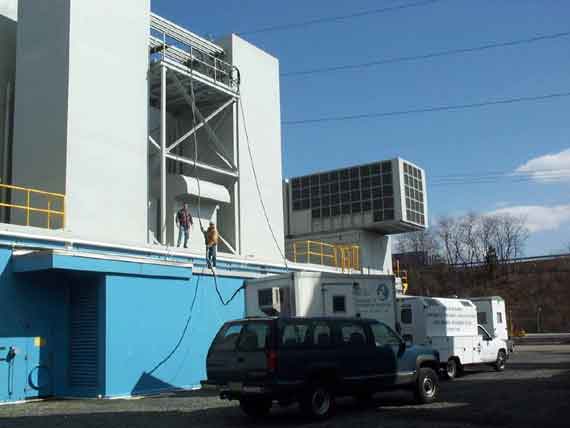As one part of New Jersey's overall State Implementation
Plan (SIP) for the attainment of the national ambient
air quality standard for ground level ozone, the state
has instituted a NOx Budget Program. The Emission Measurement Section (formerly Bureau of Technical Services) is responsible for overseeing the manner in
which affected New Jersey sources measure and report
their NOx emissions.

EMS Personnel install sampling
lines at an electric power production facility. EMS
has the ability
to assess the accuracy of a source's reported NOx emissions
for the NOx Budget Program.
Ozone/Smog/and NOx
Ground level ozone, or "smog", plagues our
State each summer, particularly during the hottest weather.
Ozone is a severe public health and environmental threat.
As a strong oxidant that adversely affects the respiratory
system, ozone impacts the health of every single citizen
who breathes the air. For the 136,000 children in New
Jersey with asthma, and the hundreds of thousands of
adults with chronic respiratory disease, high level
smog days mean staying indoors or else risking serious
health consequences. Two major players contributing
to the formation of ground level ozone are the oxides
of nitrogen, NO and NO2. Collectively known as NOx,
these two contaminants react with volatile organic compounds
(VOC), atmospheric oxygen and sunlight to form ground
level ozone. It is this form of ozone that, together
with reactive hydrocarbons, can form smog.
One Control Measure
As part of its attempt to reduce ozone in the State,
the NJDEP has initiated a number of programs to reduce
NOx. Through a joint effort with several other northeastern
State members of the Ozone Transport Commission, New
Jersey has helped formulate and now participates in
one such program on a regional level. It is called the
NOx Budget Program.
Initiated in 1999, the NOx Budget Program requires
certain large sources of NOx (primarily electric power
sources and petroleum refineries), to monitor the total
amount of NOx produced at their facilities during the
warm weather "ozone season" (May 1st through
September 30th). A yearly ozone season State "cap"
or limit is set for the total of all these sources and
through an allotment process each source is assigned
an individual "limit" on the total NOx which
they can produce. Sources that exceed their individual
"limit" must buy "credits" (portions
of other source's allotments that are marketed for sale
by those sources) of else face penalties.
A Long Term Strategy
By progressively lowering the Statewide "cap"
over the course of several years, each individual source's
allotment becomes more restrictive. Through this restriction
the "dirtier" sources are forced to either
cut production, clean up their source, or buy from sources
that find it economical to reduce the NOx at their source.
New Jersey's set goal is an ultimate "cap"
that is equivalent to the 1990 NOx output levels. The
bottom line is a Statewide average NOx production rate
for these sources that is consistent with "clean"
performance standards.
Monitoring NOx: An Essential
Tool
A critical element in the ultimate success of the NOx
Budget Program is an accurate and reliable measuring
and reporting system for individual source NOx production.
The Emission Measurement Section (EMS), (formerly Bureau of Technical Services is responsible
for overseeing the manner in which sources regulated
under this program measure and report their NOx emissions.
This involves an engineering review of source monitoring
approaches as well as quality assurance of equipment
utilized to monitor NOx output.
Today, all 319 New Jersey affected sources have approved
monitoring plans and, where required, certified continuous
emission monitoring systems (CEMS) to accurately monitor
NOx output. This is bringing New Jersey one step closer
toward its goal of attainment of the national ozone
standard and clean, healthy air.
Federal Expansion Of The Program
More recently, the Federal Government, through USEPA's
Clean Air Markets Division (CAMD) has, with slight modification,
expanded this base program to include 22 States in the
Northeastern portion of the country. Mandated participation
begins in May 2002 for affected New Jersey sources. |